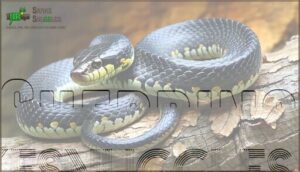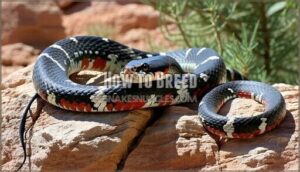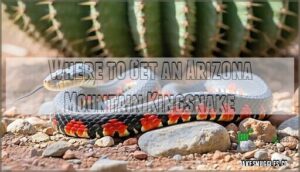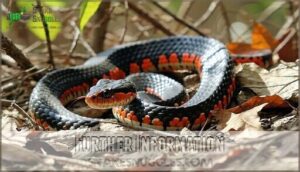This site is supported by our readers. We may earn a commission, at no cost to you, if you purchase through links.
 Arizona mountain kingsnake care centers on creating a desert mountain environment with proper temperature gradients and hiding spots.
Arizona mountain kingsnake care centers on creating a desert mountain environment with proper temperature gradients and hiding spots.
You’ll need a secure enclosure with temperatures ranging from 75-85°F and a basking area at 90°F.
These stunning red, black, and white banded constrictors require appropriately-sized prey every 7-14 days and moderate humidity levels.
Their secretive nature means multiple hiding places are essential for reducing stress.
Success depends on maintaining consistent environmental conditions to prevent common issues like parasites, dehydration, and shedding problems that can shorten their impressive 15-20 year potential lifespan in captivity.
Table Of Contents
- Key Takeaways
- Description
- Captive Care
- Common Health Problems
- Behavior
- Lifespan
- Reproduction and Development
- How to Breed
- Where to Get an Arizona Mountain Kingsnake
- Sleeping Habits
- Further Information
- Frequently Asked Questions (FAQs)
- What is the Arizona Mountain King Snake Care Guide?
- Are mountain king snakes endemic to Arizona?
- Are Arizona mountain kingsnakes diurnal?
- Are Arizona mountain kingsnakes venomous?
- Are Arizona mountain kingsnakes constrictors?
- Do Arizona mountain kingsnake brumate?
- What do Arizona kingsnakes eat?
- How big do Arizona Mountain King snakes get?
- What is the lifespan of an Arizona king snake?
- What size tank does a king snake need?
- Conclusion
Key Takeaways
- Create a proper environment – You’ll need a 3-foot enclosure with temperatures from 75-85°F, plus a 90°F basking spot, and maintain 40-60% humidity with multiple hiding places.
- Feed appropriately sized prey – You should offer frozen-thawed rodents every 7-14 days, choosing prey no wider than your snake’s thickest body section.
- Monitor for common health issues – You’ll need to watch for parasites, dehydration, and shedding problems, which can significantly impact their 15-20 year lifespan in captivity.
- Understand their natural behavior – You’re caring for a diurnal constrictor that uses mimicry defense and prefers to hide, so don’t expect a highly interactive pet snake.
Description
The Arizona Mountain Kingsnake (Lampropeltis pyromelana) captivates reptile enthusiasts with its striking mimicry defense and vibrant banding patterns.
You’ll recognize this non-venomous species by its distinctive red, black, and white or yellow bands that circle the body—a clever evolutionary trick that mimics dangerous coral snakes.
These beautiful serpents reach 18-42 inches in length, with subspecies variation creating subtle differences in coloration and size patterns.
Four recognized subspecies exist, including the Arizona, Huachuca, Utah, and Chihuahua mountain kingsnake morphs, each displaying unique color variations.
While kingsnake morphs don’t show the dramatic color differences seen in other species, you’ll notice slight variations in band width and intensity, and their smooth, shiny scales and light-colored snout complete this stunning package.
This stunning package is considered among the world’s most beautiful snakes, with the combination of its appearance and behaviors making it a notable species.
Captive Care
Caring for your Arizona Mountain Kingsnake requires specific attention to housing, feeding, temperature, and humidity needs. Proper setup guarantees your snake thrives in captivity with minimal health issues.
Housing
Your kingsnake needs proper housing to thrive. A medium-sized reptile enclosure with a secure lid works best for adult snakes.
For Enclosure Size, provide at least 3 feet long by 18 inches wide. Choose Substrate Types like aspen shavings or cypress mulch for easy cleaning.
Create multiple Hiding Spots using commercial hides or cardboard boxes at both warm and cool ends. Add Climbing Needs with sturdy branches since these snakes enjoy vertical space.
In case of illness, remember to prioritize stress-free housing to aid recovery. Include Enrichment Ideas like different textures and occasional rearrangement to keep your snake mentally stimulated in their kingsnake enclosure.
Feeding
Now that your snake’s home is set up, you’ll need to establish proper feeding habits. Your Arizona Mountain Kingsnake’s diet should consist of appropriately sized frozen thawed rodents.
Prey size matters – choose items no wider than your snake’s thickest body section. Adult feeding frequency runs every 7-10 days, while juveniles eat more often.
These kingsnakes can be picky eaters, sometimes refusing meals without reason. Consider buying feeder rodents to guarantee a consistent food supply.
Stick to a consistent reptile feeding schedule and avoid supplementation unless advised by a veterinarian, ensuring the health and well-being of your Arizona Mountain Kingsnake.
Temperature and Humidity
Creating the perfect thermal environment for your kingsnake requires careful attention to temperature gradients and humidity levels.
You’ll need to establish an ideal gradient from 75-85°F using heat mats or ceramic heaters with reliable monitoring tools like digital thermometers.
Maintain humidity between 40-60% through occasional misting, especially during shedding periods.
Consider using a kingsnake heat mat to achieve ideal temperatures.
Seasonal variation in your home’s temperature may require adjustments to heating elements.
Different areas of the enclosure create natural microclimates that support your snake’s thermoregulatory needs.
Shedding
Every three to six months, your Arizona Mountain Kingsnake will undergo ecdysis, displaying clear shedding signs like cloudy eyes and dull skin.
You’ll notice decreased activity during this natural reptile shedding process.
Maintain proper humidity levels around 60-70% to prevent retained shed on tail tips or eye caps.
Most kingsnakes complete snake shedding independently, but you can aid shedding by providing rough surfaces like bark.
Monitor shedding frequency patterns, as irregular cycles may indicate health issues requiring veterinary attention.
Common Health Problems
Even the healthiest Arizona mountain kingsnakes can face common health issues that you’ll need to watch for as an owner.
Regular monitoring and proper care help prevent most problems, but knowing what to look for guarantees you can act quickly when issues arise.
Internal and External Parasites
Over 60% of wild Arizona Mountain Kingsnakes carry parasitic infections, making parasite identification a vital skill for responsible owners. Internal parasites like roundworms and coccidia can cause weight loss and lethargy, while external parasites such as snake mites create skin irritation and excessive shedding.
Common transmission vectors include:
- Contaminated substrate or equipment
- Wild-caught snakes without quarantine
- Poor enclosure sanitation
- Cross-contamination between habitats
Treatment options require veterinary supervision, typically involving antiparasitic medications like fenbendazole. To address these infestations, many owners seek effective snake mite treatments.
Preventative measures include quarantining new snakes for 30-90 days and maintaining proper hygiene. Schedule vet checkups every 6-12 months for fecal analysis, as up to 40% of routine screenings detect parasitic eggs or cysts in pet kingsnakes.
Dehydration and Regurgitation
You’ll notice that dehydration and regurgitation often stem from preventable husbandry mistakes.
Poor water availability and inadequate humidity levels create the perfect storm for snake dehydration. Enclosure hygiene matters too—dirty bowls discourage drinking.
Stress factors like handling after meals trigger reptile regurgitation, while oversized prey overwhelms their digestive system.
Monitor your snake’s behavior closely, as feeding frequency adjustments may prevent these issues.
Understanding how to avoid environmental stress factors is vital for prevention.
| Issue | Primary Causes | Prevention Methods |
|---|---|---|
| Dehydration | Low humidity |
Shedding Problems
When shedding goes wrong, your arizona mountain kingsnake needs your help to prevent serious complications.
Stuck shed occurs when reptile shedding doesn’t complete naturally, often due to humidity impact being too low during this critical process.
You’ll notice retained skin patches, especially around eye caps and tail tips.
Kingsnake shedding typically happens every 4-8 weeks, with shedding frequency increasing in younger snakes.
Aiding shedding involves raising humidity to 60-70% and providing rough surfaces for rubbing.
Snake shedding tips include soaking in lukewarm water and gently removing stubborn pieces with damp cloth, using a damp cloth.
Preventing Illnesses
Prevention beats treatment when caring for your Arizona Mountain Kingsnake. Smart snake health management starts with consistent hygiene protocols and proactive monitoring. Watch for behavioral changes that signal trouble brewing.
Your prevention toolkit includes:
- Weekly substrate changes to stop harmful bacteria from taking hold
- 30-day quarantine procedures for new snakes to protect your collection
- Daily water bowl cleaning to prevent reptile parasites from spreading
- Regular veterinarian checkups to catch problems before they become serious.
Nutritional support through proper feeding schedules reduces stress and strengthens immunity against common reptile health issues.
Behavior
Understanding your arizona mountain kingsnake’s behavior will help you provide better care and build a stronger bond with your pet. These snakes exhibit fascinating diurnal activity patterns, staying most active during daylight hours when they’d naturally hunt in the wild.
Their temperament is remarkably docile, making them excellent companions for both beginners and experienced keepers. Arizona mountain kingsnakes possess an elusive nature in captivity, often preferring to hide under logs or rocks during rest periods.
Their hunting style involves constricting prey, and you’ll notice they maintain these predatory instincts even as pets. The most striking aspect of snake behavior is their mimicry defense mechanism. When threatened, they’ll display their vibrant bands to mimic venomous coral snakes, effectively deterring potential predators.
This reptile behavior showcases their intelligence and survival adaptations. One key aspect is understanding their defensive snake postures, such as coiling. Your kingsnake behavior guide should include understanding their calm demeanor and natural curiosity about their environment.
Lifespan
Your arizona mountain kingsnake’s lifespan depends heavily on whether it lives in the wild or captivity.
Wild longevity averages 12-15 years, while the captivity advantage extends this to over 20 years with proper care.
Environmental impact plays a significant role in determining maximum age – wild snakes face predators, food scarcity, and harsh weather conditions that captive snakes don’t encounter.
Genetic factors also influence kingsnake lifespan, though consistent care typically outweighs hereditary limitations.
Your snake’s reptile lifespan will benefit from controlled temperatures, regular feeding schedules, and veterinary monitoring.
Temperature regulation proves particularly important since these ectothermic creatures rely on external heat sources for metabolic function.
Maintaining proper husbandry practices directly correlates with snake lifespan extension.
You’ll find that captive specimens consistently outlive their wild counterparts when provided with appropriate housing, nutrition, and healthcare throughout their lives.
Some rattlesnake species, like the Timber Rattlesnake, have a wild lifespan of 20 years.
Reproduction and Development
Now that you understand how long these remarkable snakes live, reproduction becomes the next chapter in their fascinating story. Arizona Mountain Kingsnakes follow predictable breeding patterns that mirror nature’s seasonal rhythms.
Breeding Season typically occurs between May and June when temperatures warm and food becomes abundant. Males track females using chemical signals, sometimes traveling considerable distances to find potential mates. The courtship process involves gentle nudging and prolonged body contact.
Key reproductive milestones include:
- Sexual Maturity occurs between 2-4 years when snakes reach 24-30 inches
- Clutch Size ranges from 3-20 eggs, depending on female size and condition
- Egg Incubation lasts 50-60 days at temperatures between 78-82°F
- Hatchling Care begins immediately as babies emerge fully independent at 8-10 inches
Successful reptile breeding requires understanding these natural cycles. Females need winter cooling periods to stimulate egg production, while proper humidity during incubation prevents dehydration. Kingsnake breeding success depends heavily on environmental conditions, nutrition, and timing that mimics their wild habitat patterns.
How to Breed
Successful Arizona mountain kingsnake breeding requires careful preparation and patience.
You’ll need healthy adults aged 2-4 years, followed by a 4-5 month brumation period at 45-55°F to trigger reproductive cycles.
After spring mating, females lay 5-12 eggs requiring 78-82°F incubation temperatures for 60-85 days.
These snakes thrive in rugged, rocky terrains.
Essential breeding considerations:
- Breeding Season timing determines your success rate
- Incubation Methods directly impact hatchling survival
- Genetic Considerations prevent inbreeding and guarantee healthy offspring
Where to Get an Arizona Mountain Kingsnake
You have several solid options for acquiring an arizona mountain kingsnake as your next reptile pet. Pet stores in Arizona and surrounding states stock these beauties, particularly during spring breeding seasons, with prices ranging from $250-$450.
However, reputable breeders offer the best selection and health guarantees. You’ll find dozens of licensed breeders advertising online through platforms like MorphMarket, often maintaining waitlists due to high demand.
Reptile expos in Phoenix, Tucson, and Las Vegas provide excellent opportunities to meet breeders face-to-face and inspect snakes before buying. Online platforms require overnight shipping with live arrival guarantees.
The adoption process from rescue organizations offers another ethical route, though availability varies. Ethical considerations matter—ensure your snake is captive-bred with proper documentation, as wild capture is illegal.
Reputable sellers provide parasite screenings, lineage records, and require proof of proper enclosure setup before completing sales.
Sleeping Habits
Looking beyond their striking appearance, your arizona mountain kingsnake follows predictable sleeping habits that’ll help you create the perfect environment.
These fascinating reptiles display complex behavior patterns that change with seasons and temperature.
Your snake’s natural rhythm includes four key sleep phases:
- Diurnal Rest – Most active during daylight hours, resting in shaded areas between activities
- Nocturnal Activity – Shifts to nighttime movement during hot summer months to avoid excessive heat
- Brumation Sleep – Enters a hibernation-like state during winter with substantially reduced activity levels
- Sleep Duration – Varies from 12-16 hours daily depending on seasonal conditions
Understanding these snake diurnal and snake nocturnal patterns helps you provide appropriate care.
Your snake behavior will mirror wild instincts, so maintaining proper lighting cycles matters.
During brumation periods, don’t worry if your pet becomes less responsive – this natural process can last several months.
Providing enclosure darkness during rest periods supports healthy sleep cycles and reduces stress in captivity.
Further Information
Many resources exist to deepen your arizona mountain kingsnake knowledge and enhance your reptile care skills.
Professional herpetological societies, scientific journals, and experienced breeders offer valuable insights into subspecies variations, conservation status, and advanced husbandry techniques.
You’ll discover fascinating details about their venom resistance abilities and mimicry details that help them survive in diverse regional habitats.
| Resource Type | Information Focus | Best For |
|---|---|---|
| Scientific Literature | Conservation Status, Subspecies Research | Advanced Keepers |
| Reptile Forums | Practical Snake Care Tips | New Owners |
| Herpetological Societies | Regional Habitats, Breeding Programs | All Levels |
| Veterinary Guides | Health Issues, Pet Snake Care | Problem-Solving |
Connecting with local reptile groups provides hands-on learning opportunities and troubleshooting support when challenges arise.
These communities understand that successful kingsnake care requires ongoing education and shared experiences from fellow enthusiasts who’ve navigated similar situations.
Frequently Asked Questions (FAQs)
What is the Arizona Mountain King Snake Care Guide?
You’ll need a 3×18-inch terrarium with 80-85°F temperatures, ReptiChip substrate, hiding spots, water dish, and proper humidity.
Feed appropriately-sized rodents every 7-10 days.
Handle gently after a two-week adjustment period.
Are mountain king snakes endemic to Arizona?
No, Arizona mountain kingsnakes aren’t endemic to Arizona. You’ll find them across Arizona, New Mexico, and northern Mexico at elevations between 3,000-9,000 feet in mountainous regions.
Are Arizona mountain kingsnakes diurnal?
Like morning sunlight breaking through forest canopy, these snakes embrace the day as their active time.
Yes, you’ll find Arizona mountain kingsnakes are diurnal creatures, hunting and exploring during daylight hours when temperatures suit their needs perfectly.
Are Arizona mountain kingsnakes venomous?
No, Arizona mountain kingsnakes aren’t venomous at all. They’re harmless constrictors that actually mimic venomous coral snakes for protection. You can safely handle them without worrying about dangerous bites.
Are Arizona mountain kingsnakes constrictors?
Yes, Arizona mountain kingsnakes are constrictors. They’ll wrap around their prey and squeeze to disrupt blood circulation, effectively killing mice, birds, lizards, and even venomous rattlesnakes before swallowing them whole.
Do Arizona mountain kingsnake brumate?
They’ll enter a period of reduced activity during cooler months, similar to hibernation.
You can expect your snake to eat less and move around minimally when temperatures drop below their comfort zone.
What do Arizona kingsnakes eat?
Surprisingly, your Arizona mountain kingsnake’s diet mirrors nature’s buffet. You’ll feed them mice, rats, birds, eggs, lizards, and even other snakes. They’re constrictors who squeeze prey before swallowing whole.
How big do Arizona Mountain King snakes get?
Arizona Mountain Kingsnakes typically reach 5 to 5 feet in length, with some specimens growing up to 36 inches. You’ll find hatchlings start around 9 inches long before reaching their full adult size.
What is the lifespan of an Arizona king snake?
With proper care, you’ll enjoy your Arizona Mountain Kingsnake for an impressive 12-15 years in the wild, but captivity extends their lifespan beyond 20 years through controlled conditions.
What size tank does a king snake need?
For an adult Arizona mountain kingsnake, you’ll need a minimum enclosure size of 36 inches long by 18 inches wide. This provides adequate space for movement and exploration.
Conclusion
Successfully maintaining arizona mountain kingsnake care requires dedication and attention to detail.
You’ll find these remarkable serpents make rewarding companions when you provide consistent environmental conditions, appropriate nutrition, and regular health monitoring.
Your commitment to proper husbandry will guarantee your snake thrives throughout its impressive two-decade lifespan.
Remember that patience and observation are your best tools for recognizing any changes in behavior or health status that require attention.
- https://reptilesmagazine.com/breeding-kingsnakes/
- https://www.snakeestate.com/kingsnakes/arizona-mountain-kingsnake/
- https://www.herpedia.com/snakes/colubrids/arizona-mountain-kingsnake-ssp.php
- https://animaldiversity.org/accounts/Lampropeltis_getula/
- https://reptilesupershow.com/mastering-snake-breeding-tips-for-healthy-serpents/





















